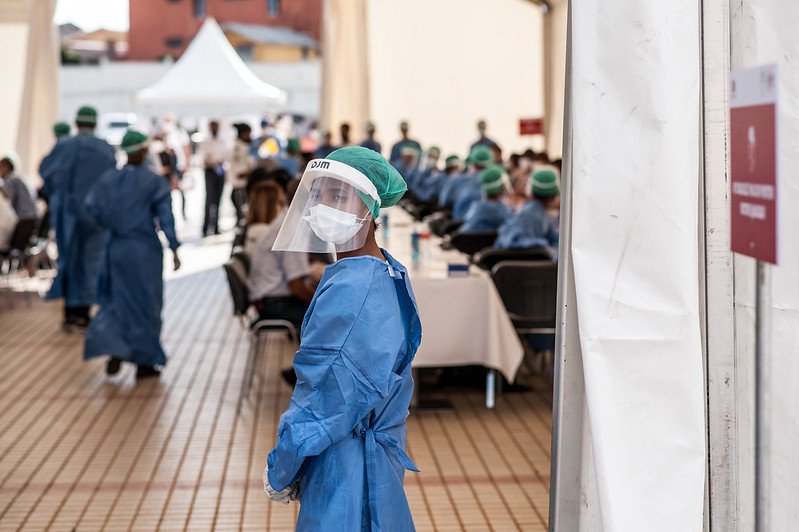In fragile and conflict-affected settings, Covid-19 is increasing vulnerabilities and tensions caused by unequal access to already strained (and often inexistent) social and medical services. This is particularly true for young people – one in every four of whom live in such areas.
Despite repeated appeals for a global ceasefire, violence is intensifying in some places whilst some peace processes are also on hold or endangered. Our response to Covid-19 must empower young people through greater inclusion in these processes, at both a local and international level.
The idea of the ‘youth burden’ – an unemployed youth bulge failing to become a demographic dividend in countries in fragile situations in Sub-Saharan Africa and the Middle East and North Africa (MENA) – often does not take into account the considerable opportunities that could be presented if we help young people regain this sense of agency.
Across sectors, Covid-19 is accelerating opportunities for collective action. Since the beginning of the crisis, youth in Mali, Cameroon, South Sudan, Syria and Haiti have acted with exemplary resilience, and in proactive and innovative ways, to support their communities. We must now seize the moment to give the ‘youth burden’ a new narrative.
Youth-led peace and security starts at the local level
In my experience of peacekeeping in the Central African Republic more than a thousand miles away from the capital, I felt a deep disconnect between time-bound international-led initiatives for peace and reconciliation and more locally-grounded processes. The latter were defined by community-led monitoring and associated response plans in case agreements were violated. Whilst both are not mutually exclusive, the lack of systematic inclusion of local actors generally resulted in a limited awareness and buy-in from them.
Translating this to the current coronavirus situation, there’s clearly a trade-off between imposing countrywide approaches ensuring consistency with what we know about the virus, and locally-led approaches that consider social dynamics in different contexts. Government and international responses are often not conflict-sensitive and do not follow a ‘do no harm’ approach. In conflict zones, young people who know their communities best have joined forces with frontline workers to fight against the pandemic. Proactively tapping into young people’s potential to play a leadership role in building resilient communities and tackling the virus must be a priority.
Humanitarian responses in the coming months are expected to take over development initiatives in fragile contexts. Hence, including young people in each phase of the humanitarian cycle by designing age- and gender-sensitive programmes that take on board local needs, existing inequalities and community dynamics will be key.
Here, the use of digital technologies and youth-driven networks will be instrumental to connect and share best practices between young people, drive behavioural changes and ensure trustworthy communication. Some of the most pressing actions for achieving this during Covid-19 include:
- increasing internet access and cell phone time;
- prioritising radio and television communication;
- using portable solar panels;
- monitoring social media disinformation; and
- supporting existing free mobile platforms such as UNICEF U-report.
Covid-19: an opportunity to reiterate commitments to youth in peace and security pledges
2020 isn’t only the year of a global pandemic outbreak reminding us how interconnected our world is. It also marks the fifth anniversary of the landmark UN resolution 2250 on youth, peace and security. The recent address on the latest Secretary General report to the UN Security Council was a call to action for more meaningful youth participation, partnerships, protection and empowerment. This includes those facing intersecting forms of discrimination and marginalisation such as young women, youth with disabilities, ethnic and religious minorities.
With governments reducing an already restricted civil society space and human rights violations rising, conditions to build peace have been made challenging under Covid-19. Nevertheless, youth-led peacebuilding initiatives are emblematic of this generation yearning for change and who “did not wait on resolutions to act” to come up with low-cost solutions.
National governments have both a role and a duty to include the youth, peace and security agenda in their national action plans through fully funded participatory processes. Peacebuilding technologies could represent a starting point to speed up this process whilst ensuring that existing inequalities aren’t being reinforced by a digital skills divide, access gaps and biased algorithms. Social media, Geographic Information Systems (GIS) and big data as well as gaming are just a few examples of how mediators have started using technologies for peacebuilding and their potential to be scaled up for youth under Covid-19.
Active youth participation requires a refocus on long-term economic inclusion
For the principle of inclusion to go beyond tokenism, the narrative around the ‘youth burden’ needs to change. Young people must be given the necessary tools to co-design programmes that enable them to thrive socially and economically and be recognised as agents of change. And this starts through education and economic inclusion for all and understanding the needs and aspirations of young people.
With Covid-19 likely to further deepen inequalities due to mass school closures, strengthening young people’s prospects to create their own livelihoods will be key to supporting peace and community resilience and to lifting the ‘burden’ of being young. Investments in building young peoples’ skills must be designed in ways that promote both a culture of peace and opportunity.
Policy responses to Covid-19 are shaping the ‘new normal’ and will have lasting impacts for those most affected, including youth living in fragile settings. Governments can no longer afford to discard youth engagement at the local level and in the peace and security agenda. They must seize the moment to embrace youth-led action for systemic change.

